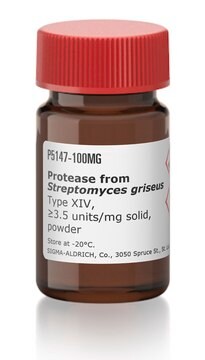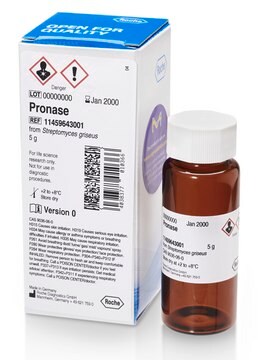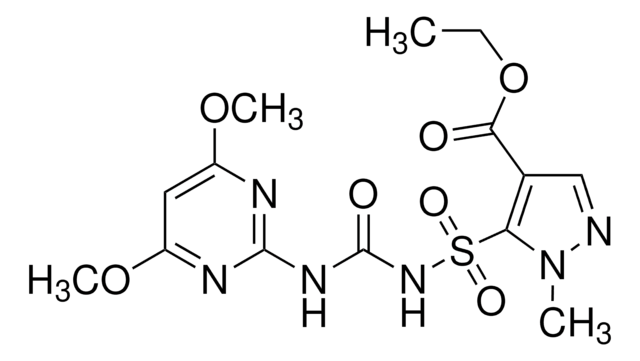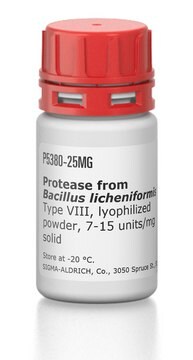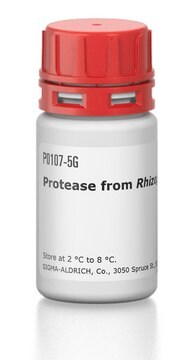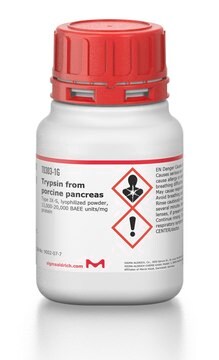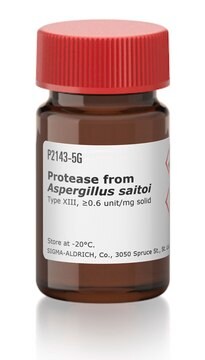53702
Pronase® Protease, Streptomyces griseus
Synonim(y):
Pronase® proszek
Zaloguj sięWyświetlanie cen organizacyjnych i kontraktowych
About This Item
Polecane produkty
opis
RTECS - UK9595000
Poziom jakości
Formularz
lyophilized
aktywność właściwa
≥45,000 proteolytic units/g dry wt
producent / nazwa handlowa
Calbiochem®
warunki przechowywania
OK to freeze
desiccated (hygroscopic)
rozpuszczalność
water: 10 mg/mL
Warunki transportu
ambient
temp. przechowywania
2-8°C
Opis ogólny
A non-specific protease liquefies mucins and digests proteins to free amino acids. Can be used to isolate living chondrocytes. Most active at neutral pH, but it is stable over a wide pH and temperature range. Has an optimal pH of 7.5. Note: 1 KU = 1000 units.
Note: 1 KU = 1000 units.
Ostrzeżenie
Toxicity: Harmful (C)
Definicja jednostki
One unit is defined as the amount of enzyme that will liberate a digestion product equivalent to 25 µg of tyrosine per min at 40°C, pH 7.5.
Postać fizyczna
Lyophilized from a solution containing calcium acetate as a stabilizer.
Rekonstytucja
Following reconstitution, store in the refrigerator (4°C). Stock solutions are stable for 24 h at 4°C.
Inne uwagi
Narahashi, Y., et al. 1968. J. Biochem. 64, 427.
Informacje prawne
CALBIOCHEM is a registered trademark of Merck KGaA, Darmstadt, Germany
PRONASE is a registered trademark of Merck KGaA, Darmstadt, Germany
Ta strona może zawierać tekst przetłumaczony maszynowo.
Hasło ostrzegawcze
Danger
Zwroty wskazujące rodzaj zagrożenia
Zwroty wskazujące środki ostrożności
Klasyfikacja zagrożeń
Eye Irrit. 2 - Resp. Sens. 1 - Skin Irrit. 2 - STOT SE 3
Organy docelowe
Respiratory system
Kod klasy składowania
11 - Combustible Solids
Klasa zagrożenia wodnego (WGK)
WGK 2
Certyfikaty analizy (CoA)
Poszukaj Certyfikaty analizy (CoA), wpisując numer partii/serii produktów. Numery serii i partii można znaleźć na etykiecie produktu po słowach „seria” lub „partia”.
Masz już ten produkt?
Dokumenty związane z niedawno zakupionymi produktami zostały zamieszczone w Bibliotece dokumentów.
Klienci oglądali również te produkty
W N Ross et al.
The Journal of neuroscience : the official journal of the Society for Neuroscience, 4(3), 659-672 (1984-03-01)
Optical techniques using voltage-sensitive dyes were used to record electrical events simultaneously from many positions on certain neurons of the barnacle supraesophageal ganglion. By signal-averaging, recordings with good signal-to-noise ratios and time resolution were obtained from fine dendritic processes as
T E Davis et al.
Infection and immunity, 15(3), 978-987 (1977-03-01)
Enzymes capable of hydrolyzing cell walls of Blastomyces dermatitidis and chemotypes I and II of Histoplasma capsulatum were prepared in the laboratory or obtained from commercial sources. They included chitinases, beta-1,3-glucanases, beta-1,6-glucanase, and Pronase. Monosaccharides and disaccharides of glucose released
Saurabh Dahiya et al.
Human molecular genetics, 20(22), 4345-4359 (2011-08-19)
Matrix metalloproteinases (MMPs) are a group of extracellular proteases involved in tissue remodeling in several physiological and pathophysiological conditions. While increased expression of MMPs (especially MMP-9) has been observed in skeletal muscle in numerous conditions, their physiological significance remains less-well
M Tsacopoulos et al.
The Journal of neuroscience : the official journal of the Society for Neuroscience, 17(7), 2383-2390 (1997-04-01)
Glial cells transform glucose to a fuel substrate taken up and used by neurons. In the honeybee retina, photoreceptor neurons consume both alanine supplied by glial cells and exogenous proline. Ammonium (NH4+) and glutamate, produced and released in a stimulus-dependent
S Kästner et al.
The journal of histochemistry and cytochemistry : official journal of the Histochemistry Society, 48(8), 1079-1096 (2000-07-18)
Satellite cells are the myogenic precursors in postnatal muscle and are situated beneath the myofiber basement membrane. We previously showed that fibroblast growth factor 2 (FGF2, basic FGF) stimulates a greater number of satellite cells to enter the cell cycle
Nasz zespół naukowców ma doświadczenie we wszystkich obszarach badań, w tym w naukach przyrodniczych, materiałoznawstwie, syntezie chemicznej, chromatografii, analityce i wielu innych dziedzinach.
Skontaktuj się z zespołem ds. pomocy technicznej